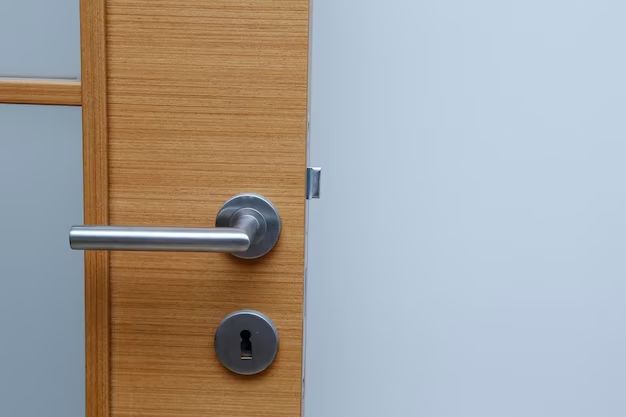Page Contents
Quick Answer
The screw size needed to hang an exterior door depends on the weight and thickness of the door, as well as the type of frame you are installing the door into. Generally, #10 or #12 screws that are 2.5-3 inches long are recommended for mounting a standard exterior door into a wooden frame. For heavier doors or metal frames, #14 screws 3-4 inches long may be needed. Deck screws or exterior-rated wood screws are best for durability.
Determining Screw Size
When determining what size screws you need to hang an exterior door, there are a few key factors to consider:
Door Weight
Heavier doors require larger, longer screws to properly support them. A standard solid wood exterior door weighs 80-120 lbs. Fiberglass or steel doors can weigh over 200 lbs. The heavier the door, the larger diameter screw you will need for adequate holding power.
Door Thickness
Most exterior doors are 1-3/4 inches thick. The screw needs to be long enough to go through the entire thickness of the door, plus extend at least 1 inch into the door frame. For a 1-3/4 inch door, a 2-1/2 to 3 inch screw is usually sufficient.
Frame Material
What your door frame is made of also determines the size screws to use. Wood frames can use wood screws, while metal door frames require self-tapping metal screws. Brick, concrete, or steel framing may need specialty anchors.
| Frame Material | Recommended Screw Type |
|---|---|
| Wood | Wood screws |
| Metal | Self-tapping metal screws |
| Concrete or Brick | Masonry screws or anchors |
| Steel Framing | Self-drilling drywall or deck screws |
Screw Composition
For exterior doors, it’s important to use screws made of corrosion resistant materials like stainless steel, brass, or coated steel. Avoid plain steel screws outside, as they can rust and deteriorate over time. Exterior wood screws are ideal for wooden frames.
Recommended Screw Sizes
Based on the factors above, here are some general recommendations for what size screws to use when hanging exterior doors:
Standard Doors into Wood Frames
For most standard 80-120 lb. exterior doors being mounted into a traditional wood frame opening, #10 or #12 screws that are 2.5-3 inches long are sufficient. These provide enough threading and penetration into the wood without risk of splitting.
Heavy Doors into Wood Frames
For heavier exterior doors over 150 lbs., step up to #14 or #16 gauge screws that are 3-4 inches long for more support. Pre-drilling pilot holes can help prevent splitting the wood.
Metal Frames
Self-tapping metal screws sized #12 or #14 work best for attaching doors to metal frames. A minimum of 3″ length is recommended, but confirm if your specific metal frame has any diameter or length requirements.
Security Doors
For heavy security doors or storm doors, use extra-long 4-6″ lag bolts through pre-drilled holes for maximum strength. Or install with security door hinges that anchor deep into the framing.
Garage Overhead Doors
Follow the door manufacturer’s instructions for sizing and spacing of screws specifically for your overhead garage door model. These are usually self-tapping and installed into the steel tracks and reinforcement plates.
How Many Screws to Use
In addition to screw size, the quantity and placement of door mounting screws is also important:
– For standard solid wood doors, use a minimum of 6-8 screws located through the door hinge plates into the frame.
– On heavier steel or fiberglass doors, use 8-12 screws evenly spaced around the perimeter.
– For wide doors over 36″, add additional screws midway up the door at the lockset and deadbolt location.
– For double doors, use screws top and bottom on the fixed inactive door as well as the main active door.
Keeping screws evenly spaced prevents sagging and provides consistent security. Stagger them top and bottom between the hinges. Pre-drilling holes minimizes splitting.
Installing the Door
Once you have selected the appropriate type and size of screw for your exterior door installation, follow these steps:
1. Hold the door in place and mark where the hinges and lockset align on the door frame. Remove door.
2. Drill pilot holes at the marked locations. Go slowly with each hole and check for plumb.
3. Partially insert screws in the top and bottom hinge locations. Do not drive in fully yet.
4. Hang door back on aligned screws. Insert shims above screws to take the weight as needed while adjusting to square in the opening.
5. Insert remaining screws in all hinge and lock locations. Tighten down fully.
6. Check door operation and make adjustments as needed to frames or shims until there is smooth action and appropriate reveal around the door edges.
7. Finish driving all screws flush to frame. Do not overtighten.
Conclusion
Choosing the proper screw size and type is imperative for a secure and long lasting exterior door installation. Heavier doors, thicker doors, and metal frames require larger, longer screws than typical installations. When in doubt, go with a slightly bigger screw for maximum holding strength. Fully seating all screws into pre-drilled holes will keep the door square and prevent operational issues down the road. Take care to properly shim and adjust until proper reveals are achieved.
